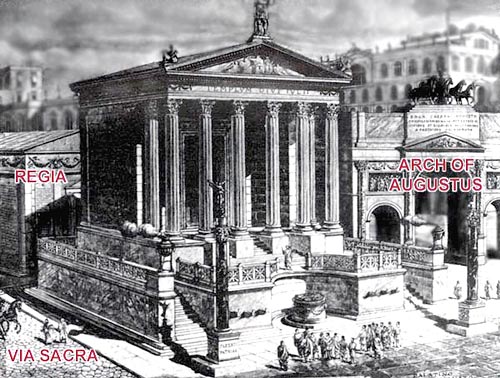
The Temple of the Divine Julius Caesar sat adjacent to the Regia on the eastern edge of the Forum, along the upper branch of the Via Sacra on the north (see Forum drawing). Caesar's body had been cremated next to the Regia after the assassination in 44 BCE. A shrine and column had been erected, but were soon destroyed by Dolabella.
Augustus conceived of the temple to replace the earlier shrine while he was still a triumvir, but was only able to carry out the project after his victory in the battle of Actium in 31 BCE; the temple was not dedicated till August 18, 29 BCE. The temple was restored by Hadrian and perhaps again later in the Empire. The temple sat behind an altar on the spot where Caesar's body was burned, where the altar destroyed by Dolabella had evidently been restored. The base of this altar can still be seen. This sacred monument was preserved in the design of the temple, for it sat in a niche in the center of the front platform of the temple, which projected on both sides beyond the stylobate. This projection was called the rostra aedis Divi Iuli, "the Rostra of the temple of the Divine Julius," a new Rostra that was to rival the older one at the other end of the Forum. Thus, the walls on both sides of the niche were decorated with beaks from the ships captured at Actium. Emperors increasingly used this Rostra, as can be seen on this coin of Hadrian speaking from the platform of this temple. On the south side of the temple Augustus later dedicated an arch, the Arch of Augustus.
![]() To follow Tristia Tresunus to his third stop, take the Arch of
Augustus exit.
To follow Tristia Tresunus to his third stop, take the Arch of
Augustus exit.